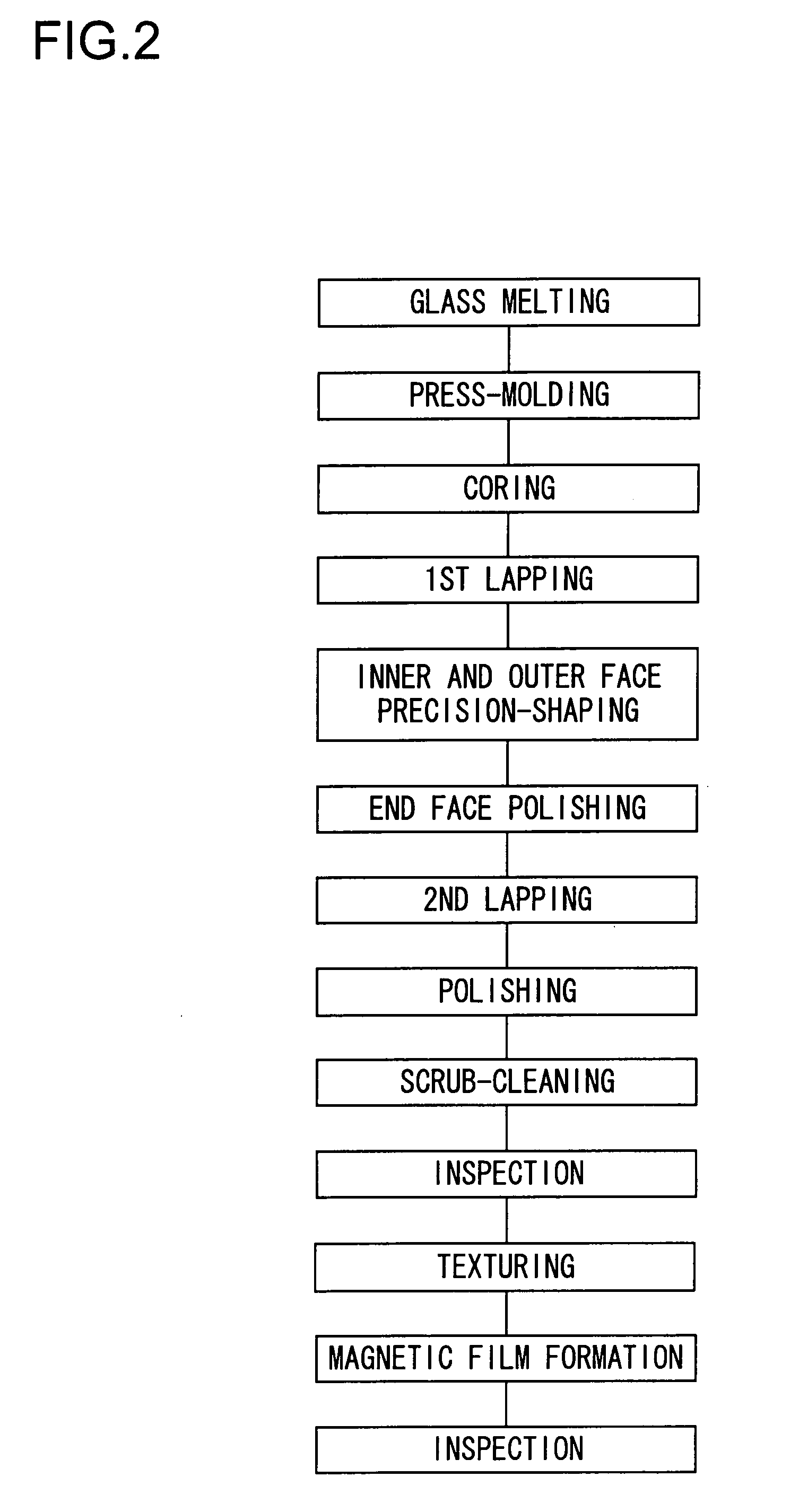Method for fabricating a glass substrate, method for fabricating a magnetic disk, and magnetic disk
a technology of glass substrate and magnetic disk, which is applied in the field of glass substrate, can solve the problems of unreasonably given explanation and non-uniform pattern of stripes to be formed, and achieve the effects of reducing the distance between the surface, uniform surface condition, and fine surface condition
- Summary
- Abstract
- Description
- Claims
- Application Information
AI Technical Summary
Benefits of technology
Problems solved by technology
Method used
Image
Examples
example 1
PRACTICAL EXAMPLE 1
[0052]An aluminosilicate glass substrate having a Young's modulus Eg of 85 GPa and containing 55% of SiO2 was polished and cleaned so that the Young's modulus Es of the part of the glass substrate from the surface to 100 nm deep ranged from 75 GPa, at the minimum, to 82 GPa, at the maximum. Incidentally, polishing and cleaning do not change the Young's modulus Eg. When texturing was then performed all over the surface of the glass substrate, a uniform pattern of stripes in the shape of concentric circles was obtained. When a magnetic film was then formed on this glass substrate, a uniform magnetic alignment in the shape of concentric circles was observed, and good magnetic recording / reproducing characteristics were obtained.
example 2
PRACTICAL EXAMPLE 2
[0053]A soda-lime glass substrate having a Young's modulus Eg of 78 GPa and containing 65% of SiO2 was polished and cleaned so that the Young's modulus Es of the part of the glass substrate from the surface to 100 nm deep ranged from 88 GPa, at the minimum, to 92 GPa, at the maximum. When mirror polishing was then performed on the glass substrate, an ultrasmooth surface having a roughness of Ra=0.15 nm was obtained uniformly all over the surface thereof. When a perpendicular magnetic film was then formed on this glass substrate, a film of minute and uniform magnetic particles was obtained, and good magnetic signal reproduction characteristics were obtained.
example 3
PRACTICAL EXAMPLE 3
[0054]A non-alkali glass substrate having Vickers hardness Hv of 630 and containing 50% of SiO2 was polished and cleaned so that the hardness Hs at the topmost surface of the glass substrate was 575. Incidentally, polishing and cleaning do not change the Vickers hardness Hv. When mirror polishing was then performed on the glass substrate, an ultrasmooth surface having a roughness of Ra=0.15 nm was obtained uniformly all over the surface thereof. When a perpendicular magnetic film was then formed on this glass substrate, a film of minute and uniform magnetic particles was obtained, and good magnetic signal reproduction characteristics were obtained.
PUM
| Property | Measurement | Unit |
|---|---|---|
| surface roughness Ra | aaaaa | aaaaa |
| Young's modulus | aaaaa | aaaaa |
| Young's modulus Eg | aaaaa | aaaaa |
Abstract
Description
Claims
Application Information
 Login to View More
Login to View More - R&D
- Intellectual Property
- Life Sciences
- Materials
- Tech Scout
- Unparalleled Data Quality
- Higher Quality Content
- 60% Fewer Hallucinations
Browse by: Latest US Patents, China's latest patents, Technical Efficacy Thesaurus, Application Domain, Technology Topic, Popular Technical Reports.
© 2025 PatSnap. All rights reserved.Legal|Privacy policy|Modern Slavery Act Transparency Statement|Sitemap|About US| Contact US: help@patsnap.com


